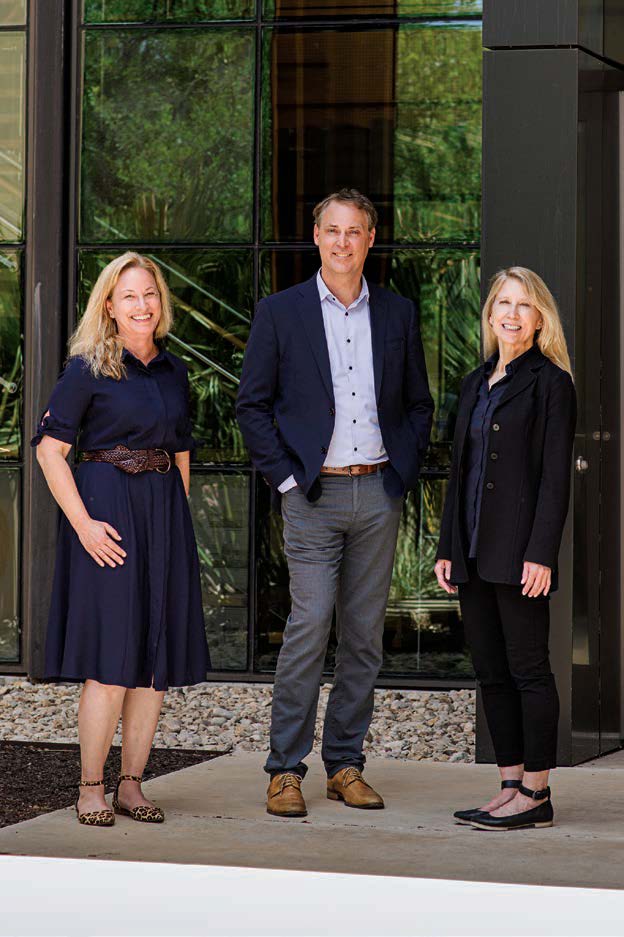FUELING THE INNOVATION PIPELINE

Texas Biomed’s scientists are unlocking solutions for tough health challenges. The expanded Business Development and Strategic Alliances team helps launch innovations and establish ever-more strategic partnerships that support the Institute’s growth, mission and impact.
There is often a long road between the Eureka! moment in the lab and an approved vaccine, medication or technology benefitting human health. “The innovation process covers all the steps in between identifying the problem and delivering an approved technology,” says Cory Hallam, PhD, Texas Biomed’s Vice President for Business Development and Strategic Alliances (BDSA). “How do we move from discovery to diagnostics, vaccines or cures? That’s the purpose of our group.”
Dr. Hallam and his team are building two complementary processes to help expand Texas Biomed’s portfolio of high-impact contributions to global health: advancing in-house innovations and strategically partnering on contract research.
“Our goal is to be in the business of putting great science into the innovation pipeline,” Dr. Hallam says. “With high quality science and strong partners, we are increasing the probability that these successes will drive returns to reinvest in the Institute’s mission.”
INWARD LOOKING OUT
As Texas Biomed’s Innovations Manager, Tracey Baas, PhD, is leading the effort to identify and protect intellectual property (IP) — such as diagnostics, therapies, vaccines and technologies — generated at the Institute. While some researchers are well versed in IP, others aren’t sure if their interesting findings might qualify, or how to develop them for commercial markets. Many simply don’t have the time to pursue the process themselves.
“We’re here to help educate and guide researchers through the process and move innovation forward,” Dr. Baas says. “Everybody became a scientist because they wanted to seek discoveries to help someone. We can bridge the gap in translating them into applications. Let’s get the science that’s so fascinating out there to benefit human health.”
Every innovation is unique, so the path will vary. The BDSA team is talking with labs and meeting with researchers in what Dr. Baas describes as the “this might be interesting” phase to discuss options.
As research progresses, the newly established Intellectual Property Advisory Committee evaluates the innovation’s potential and if it should be copyrighted, trademarked or patented. The committee comprises internal and external members, including a representative from a market research firm who assesses the competitive landscape and what additional development might be required before companies might become interested.
Cory Hallam, PhD,
How do we move from
discovery to diagnostics,
vaccines or cures? That’s the
purpose of our group.
VP for Business Development
and Strategic Alliances
Texas Biomed excels in basic research and preclinical studies, but as a nonprofit, the Institute is not set up to manage the final phases of the innovation process, such as conducting large human clinical trials or producing products at scale.
That means partnering in one of a few ways: licensing the innovation to an existing company that works to move it to market; partnering with an organization that funds and runs clinical trials, while overseeing the remainder of the process at the Institute; or spinning off a company that raises private funding to advance to market.
“What’s new for Texas Biomed is we’re considering all three of those mechanisms as part of our tactics for success,” Dr. Hallam says.
OUTWARD LOOKING IN
At the same time, Texas Biomed’s Director of Business Development and Strategic Alliances, Heidi Meisenkothen, is building global partnerships to bring in more contract research and funding. She is doing this with a keen eye towards ongoing collaborations that could evolve into joint ventures or investment in Texas Biomed innovations.
“We’re thinking about which partners can strategically help the Institute innovate and grow, and how we can bring in new technologies or capabilities that our researchers are interested in working with,” Meisenkothen says. “It’s exciting because there are so many facets and ways we can connect to move healthcare solutions forward.”
Texas Biomed has a stellar reputation for its high-quality preclinical testing capabilities, and the number of contract research requests from companies to test their diagnostic, therapy, vaccine or technology doubled from 2020 to 2021. For example, Texas Biomed worked on Regeneron’s Ebola treatment and COVID-19 antibody cocktail, as well as COVID-19 vaccines for Pfizer-BioNTech, Novavax and EuBiologics.
Meisenkothen is also working with teams across the Institute to further streamline the partnering process for contract research. A new Innovation Lab was launched in 2021 specifically designed to handle a high volume of smaller contract projects.
The synergies between the outward- and inward-looking business development processes are hard to miss.
“The expanding pipeline of what we’re creating and the expanding partnerships of who we are helping fit together very well,” Dr. Hallam says. “These external relationships provide us with natural partners to help us spin off new companies for discoveries from our labs.”